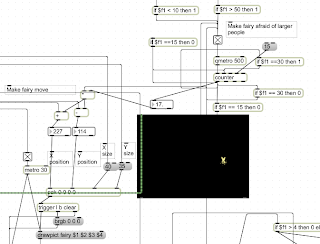Our design team sat down together today to brainstorm possible ideas for a responsive environment that would involve the basic components of a camera, projector, and screen.
In our ideas we wanted to ensure that there was quality in the interaction, that incorporated unique senses. First, we brainstormed possible variables that could be detected. We threw out terms such as motion, distance, frequency, speed, sound, temperature, size and quantity. We took these further and applied them to possible concepts. Below are some of the concepts we came up with:
Concept 1: Needy Room
This concept was taking into account a direct impact of the projection based on human movement. A projector would be placed overhead, projecting glowing balls of light on the ground. The more people clustered in a space, the bigger the blobs get. If there are areas in the space that are empty, a sound element could be incorporated that would subtly indicate that the space is lonely and needs more people.
Concept 2: Footstep Companion
This idea would consist of a projector up above that displays glowing footsteps on the ground. A camera would track the movements of the participants, which would affect the movement of the footsteps. These footsteps would act as an invisible companion, presumably to a child, by walking beside him or her. Where the footsteps could also skip ahead or walk using unique patterns, forcing the participant to follow it and turning the nature of interactions into more of a game.
Concept 3: Imitating Subconscious Actions through Fiber-Optics
This idea was inspired by the tendency of natural, subtle movements, such as lightly tapping feet on the ground, or rubbing one's arm upon feeling cold. We thought it would be interesting to exaggerate a subtle movement in order to anticipate the upcoming action. An example that was brought up was the technique of drawing comics. If the artist was to draw a character sitting up, he or she would first have picture the character slightly leaning back before actually getting up. This lead to a tangible concept, where through fiber optics, we would use the current movement of the participants to exaggerate and almost "fast forward" the action to create an anticipatory environment.












